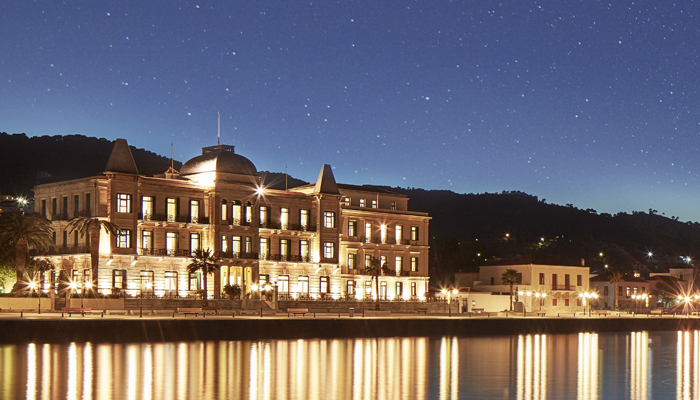 The
Poseidonion Grand Hotel/Photo courtesy of Poseidonion/credit: Christos Drazos The
Poseidonion Grand Hotel/Photo courtesy of Poseidonion/credit: Christos Drazos
Midnight
in ... Spetses: A
Belle Époque Weekend in
Tweed
A personal essay
from the 4th Annual Tweed Run in
Spetses
by Athina Vorilla
In Woody Allen’s 2012 Academy Award-winning film, Midnight in Paris,
screenwriter Gil (played by Owen Wilson) goes back in time; magically
transported — via antique car — to 1920’s Paris where he hobnobs
with the legendary literati of the time, Dali, the Fitzgeralds,
Hemingway et al.
In one scene, Gil tries to explain this bizarre occurrence to his new
friends from the past saying, “I’m from a different time, another era,
the future. I come from the 2000th millennium to here. I get into a car
and I slide through time.”
Such was the feeling elicited in me on my recent trip to the island of Spetses; an experience that can only
be described as dreamlike: whimsical, winsome and wonderful.
Invited to attend the 4th Annual Tweed Run
Spetses - 2017,
it was — from the moment I stepped foot on the island — as if I had
been cast in a movie set to take place during the belle époque.
It started with my accommodation at the Poseidonion
Grand Hotel. Just three hours away from my home base
in
Athens, I had never visited the historic landmark hotel on the island in the Argosaronic
Gulf.
Befitting host of the Greece Tweed
Run event for a 4th consecutive year, the Poseidonion Grand Hotel could be a
backdrop for a movie circa 1900s.

The
Poseidonion Grand Hotel, Tweed Run Spetses 2017/Photo courtesy of Poseidonion/credit: Nikos Kokkas
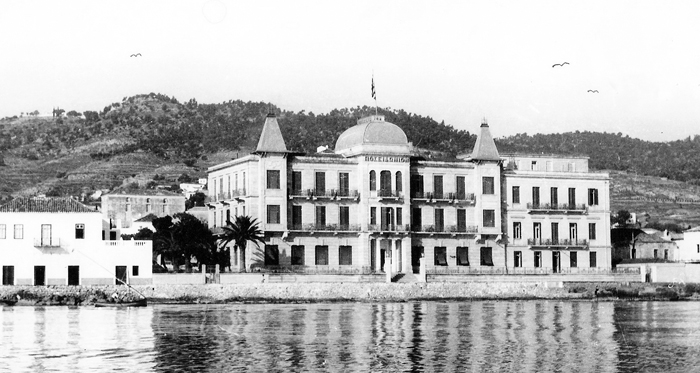
Photo courtesy of Poseidonion Grand Hotel.
Originally built in 1914, the hotel -- an example of European
eclectic architecture -- boasts many
firsts: it was the first luxury hotel to be built outside of Athens;
the first Greek hotel to offer spa services; and the site that inspired
highly-respected Greek politician and Prime Minister, Eleftherios
Venizelos, to establish a state office dedicated to Greek tourism at
the hotel’s ribbon cutting ceremony.
Of course, having heard of its massive renovation (begun in 2004) and
heralded reopening in 2009, I was thrilled at the chance to stay at
this magnificent, over-a-century-old grand hotel and to take part in
the Tweed Run Spetses.
Held in cooperation with the Hellenic
Bike Museum and under the auspices of the Municipality of Spetses and the Spetses Trade Association,
the stylish cycling event is just one of several stellar classic events
hosted by the hotel annually. (Other events include the Spetses Classic
Yacht Regatta, the Spetses Mini Marathon;
the Spetsathlon, and the Spetses Classic Car Race).
The Tweed
Run is a London-based
event that was first established in 2009. Since then it has grown to
include other cities and destinations such as Spetses, Tokyo and my
native New York.
Off to Spetses!
Valise in tow, I arrive at Piraeus
port, gate E8, just a few minutes shy of the 9:00 am sharp departure.
It is late April and weather is classic Athens spring: approximately
15° Celsius and what I like to call curiously cloudy, when the sun
could — or could not — appear at any time.
Perfect weather for tweed, I think to myself as I board the high-speed
catamaran Flying Cat 5; the largest of the three vessels scheduled to
depart today for Spetses.
The trip is pleasant and the ride — with just 3 or 4 on the Beaufort
wind scale — is smooth.
Today’s route includes stops at three ports before reaching the final
destination of Spetses: the
pine tree-studded island of Poros,
home of Greece’s first naval academy; the amphitheatrically-built Hydra,
a favorite haunt of artists, Brice Mardin and the late Leonard Cohen;
and the little, but strategically key, since ancient times, port town
of Ermioni in the Peloponnese.
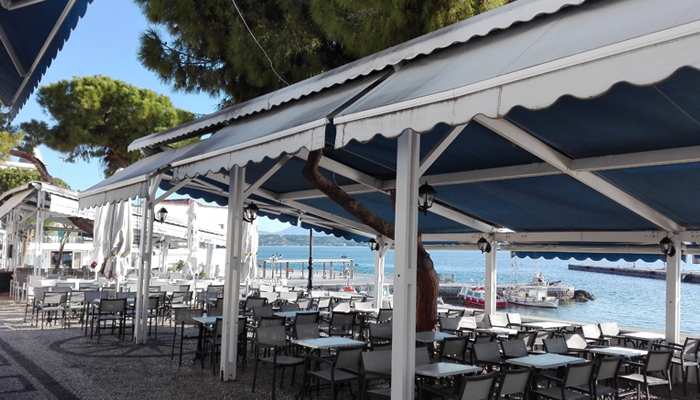
Dapia,
Spetses. Photo: Personal Archive
Arrival on Spetses
We arrive on Spetses on time. It is 12 noon. I opt to
give my luggage to the bellhop waiting at Dapia, the island’s charming port.
This allows me to enjoy the 5-minute walk to the hotel.
Stepping gingerly on the fish-motif cobblestone paths
(the sprawling octopus is my favorite), I make my way across, exchanging Kalimeres (wishes of good morning) and warm smiles with the local merchants.
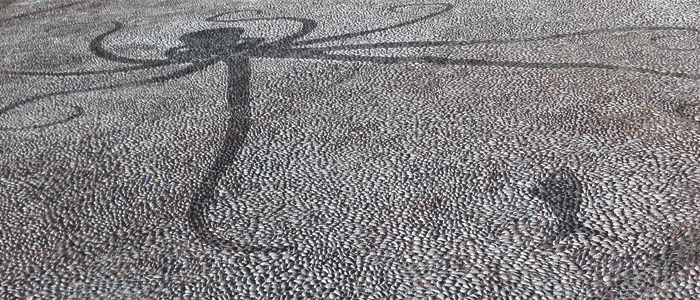
Dapia,
Spetses. Photo: Personal Archive
On my right, and just below the elegant waterside cafes, are the
distinct white and orange water taxis. Lined up side to side and
perfectly docked upon the calm crystal clear blue waters, they rock to
and fro in unison.
The water taxis await passengers wishing to jet
across the Spetses channel to
the port town of Kosta. In
view and at arm’s length distance, Kosta,
located on the southernmost
leg of the Peloponnese in the Argolida
region, it features parking and subsequent sea connections
to people
traveling by car to Spetses via the mainland. (Cars are not allowed on
Spetses).
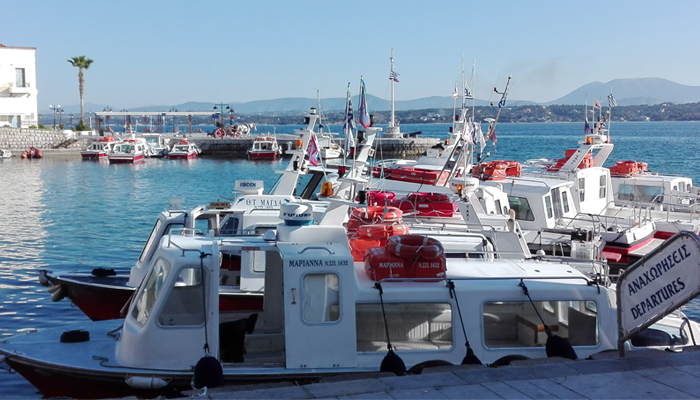
The characteristic water
taxis at the port, Dapia, Spetses./Photo: Personal Archive
I continue walking and, in just a few more
steps, the mosaic-like path
gives way to a massive white marble pier-like esplanade. Affixed on the square,
commanding presence, is the formidable
Poseidonion Grand Hotel.
Midnight in … Spetses
It is here that my “cinematic” tweed weekend in Spetses begins.
Feeling as if I had just embarked on a mansion of a long lost relative,
I immediately feel at home.
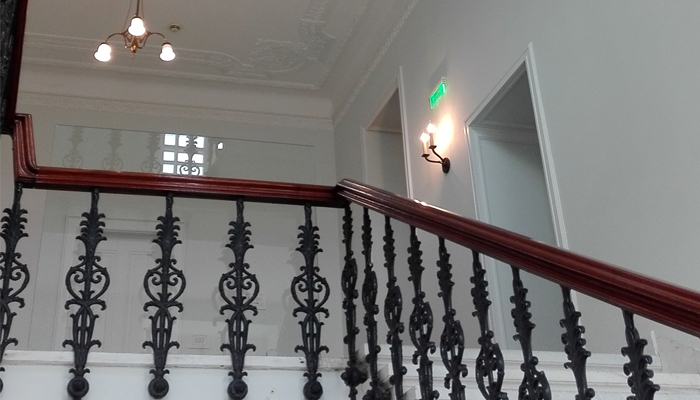
The hotel's magnificent
marble staircase./Photo: Personal Archive
In childlike fancy, I run up the magnificent marble staircase to my
room on the 2nd floor to get dressed.
Luckily, I had a few items that fit the required dress code etiquette
for the Tweed Run:
a black and white tweed vest, white ruffled blouse, black riding pants,
1920s laced-up granny boots, and a grey and black pinstripe newsboy cap.
Dressed and ready, I quickly register to take part and hurriedly make
my way to the nearest bicycle shop (there are four on the island) to
rent a bicycle.
There, I see an aptly dressed "tweeder" wearing a blush-pink pleated
dress with a button-downed top and bow, grey tweed jacket (belted at
the waist) and straw bonnet.
“The dress is vintage French and the jacket vintage English,” says
Sophia Danaka, owner of a vintage shop in Athens that imports European
clothing.

Photo: Personal Archive
Back at the hotel, I park my bicycle next to the multifarious
collection of vintage bicycles that line the entrance. Among them is a
black 1923 Peugeot luxe loop frame
from France, a 1950
fire-engine red
English Raleigh and an amazingly restored shiny black 1957 German
Bismarck.
Some bikes have large shiny lamps, bells and fancy horns,
while others have intricately carved leather seats and saddles. Bicycle
baskets filled with picnic blankets and graced with flowers, fruits and
a variety of accessories add to the cycling finesse.
In and out of the hotel lobby, participants dressed in classic Tweed Run garb, bustle to make the
final adjustments to their look.
In the living area/main lobby barbers groom mustaches while shoe
shiners polish shoes and hairdressers perfect coiffures. Donning just
fours, argyle socks, tweed vests, bow ties, cycling skirts and capes,
red lipstick for the ladies and pipes for the men, the scene is
surreal. Gathered in the historic landmark hotel close to 200 people
dressed in Gatsby-style attire.
“It’s like jumping out of a 20’s movie,” says Sophia. “The hotel, the
people, the music, the bicycles, the island, everything,” she says.
The Tweed Run - Spetses
The bicycle tour begins. Approximately 2km in total distance, it will
offer the dozens of tweed runners a sightseeing snapshot of Spetses.
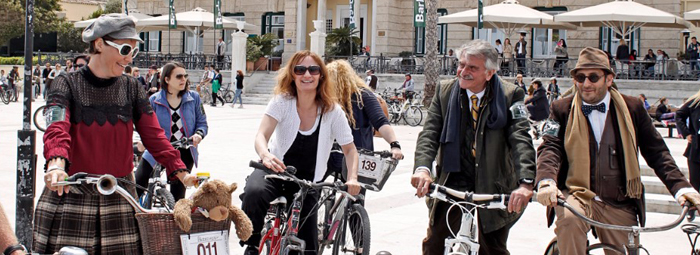
Photo courtesy of Poseidonion/credit: Nikos Kokkas
Exiting the Poseidonion,
in
the center of the square, we encounter one of the most recognized Greek
island attractions: the brass statue of Laskarina Bouboulina. The monument,
by sculptress Natalia Mela,
depicts the fearless Spetses war heroine known for her instrumental
role in the Greek Revolution of 1821.
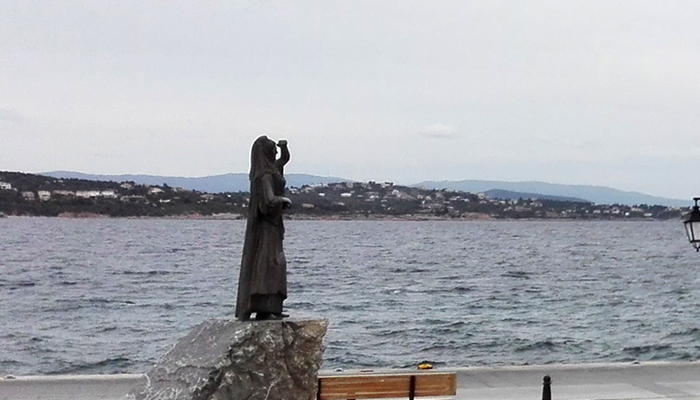
Sculpture of
Laskarina Bouboulina at Poseidonion Square, Spetses./Photo: Personal Archive.
We continue, west, along the seaside road for a few hundred meters to
stop for tea on the grounds of The Anargyreios and Korgialeneios School of
Spetses.
The school, originally modeled after Britain’s Eton College, and built
in 1927, was funded mainly by Sotirios Anargyros, the island’s great
benefactor who also built the Poseidonion. The school, a complex of
five buildings covering an area of 120 acres, now serves as a
conference and events venue. The school is where author John Fowles
taught English. His time on Spetses inspired his novel, The Magus.
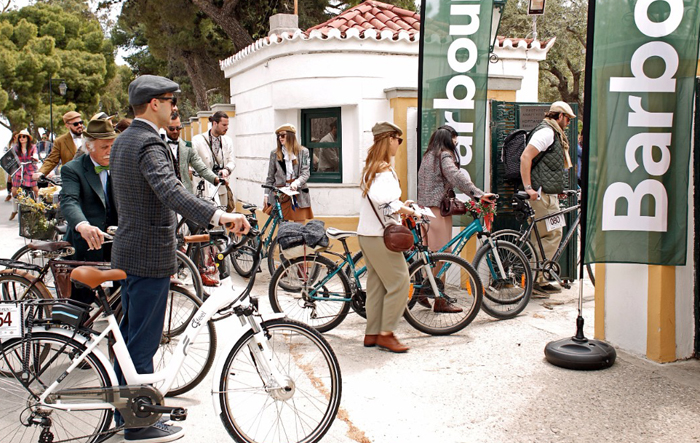
Photo courtesy of Poseidonion/credit: Nikos Kokkas
The weather is overcast, reminiscent of London and
most suitable for
tweed. Rain seems imminent, but we pedal on, reveling in the luxury of
cycling in such beautiful surroundings with a rich heritage and
historic past.
After tea, we turn around and head back east, for approximately 1km.,
to the Old Port and our
second pit stop at Orloff, the
island’s former customs office and now popular seaside dining
spot. A busy seafaring and shipping center, Spetses was
one of the region’s most active naval centers. Today, we are toasting
with a choice of aperitif — ouzo or tsipouro — and nibbling bite size
shrimp, olives and tomatoes.
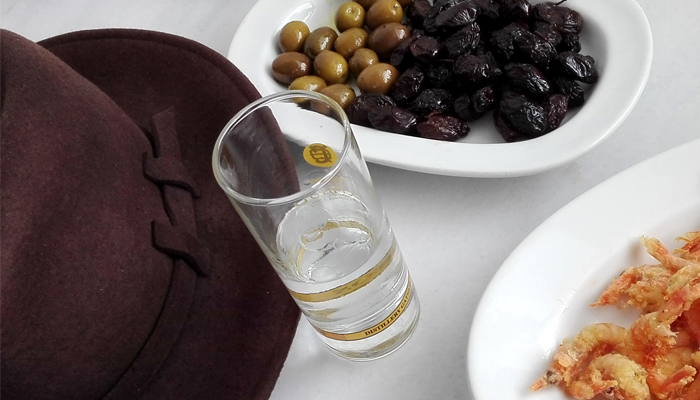
Photo: Personal archive.
Despite the drizzling rain, we continue towards the Lighthouse. Standing tall is on the
hill is another distinct statue by Natalia
Mela: that of a young captain Barbatsi,
an additional key figure in the Spetses
naval battle in the Greek War of Independence.
Taking in the breathtaking views of the blue waters and green of the Peloponnese mainland across the Spetses
strait, we cover up with the handy disposable waterproof ponchos
provided by the organizers as we relish the special picnic lunch
prepared by the Poseidonion's chef, Stamatis Marmarinos.
After the light rain and light lunch, we make our way back to the
charming courtyard of the Bouboulina Museum for the
vintage bicycle awards ceremony.
Gathered here are vintage bicycling enthusiasts eager to be rewarded
and recognized for their vintage bicycle restoration work in the
categories: Classic Bike, Town Bike,
Race Bike and Best Decorated Bike.

Award ceremony in the
Bouboulina Museum courtyard./Photo: Personal Archive
“We designed and created a special trailer to transport our bicycles
just for this event,” say members of the group known as Klasikoi Podilates, or Classical Cyclists.
The group of five friends have come to the Tweed Run Spetses for a second year
in a row, making the 11-hour trip from Thessaloniki.
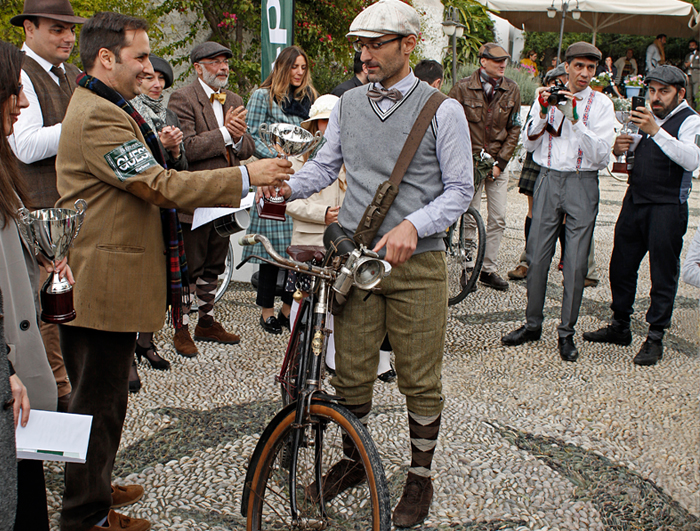
Recipient of Best Decorated Bike Award/Photo courtesy of Poseidonion/credit: Nikos Kokkas
Ioannis Tsoukalis, member of the group and winner of
the Best
Decorated Bike for
his 1923 Peugeot adds: “We enjoy the Tweed Run Spetses because it
brings together people who enjoy the same hobby. We have a chance to
exchange ideas in a friendly and fun environment.”
“I wish all my weekends were spent like this,” says Dimitris
Karagiorgas who won 2nd place in the Classic Bike category, for his
restored 1957 Bismarck. “It was like we were living in another
century.”
Almost midnight … in
Spetses
It’s later in the evening and the the jazz-age theme continues at the
hotel with an after-event party and beauty pageant. Here, men and women
of all ages, showcase their vintage flair, competing in the categories
of Best Dressed Male, Best Dressed
Female, Best Group Entry, Best Mustache and Best Child Entry.
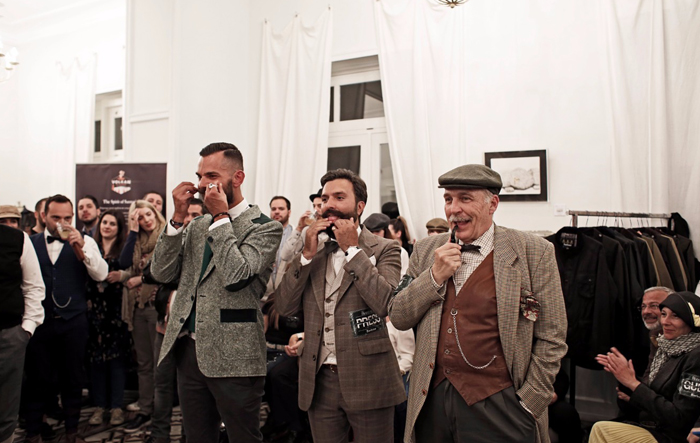
Winners in the category Best Mustache/Photo courtesy of Poseidonion/credit: Nikos Kokkas
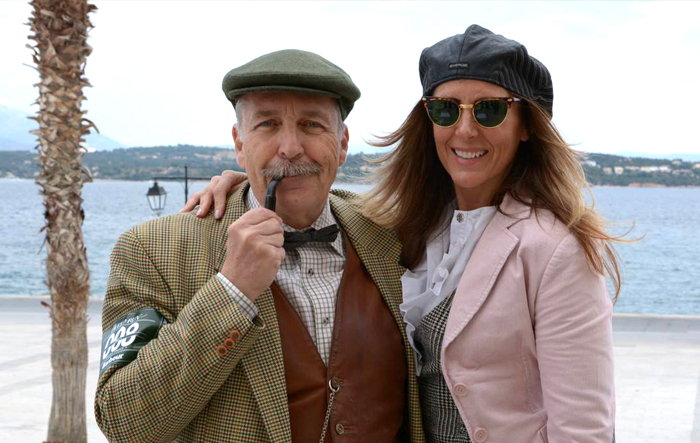
Yours truly with Petros
Petrokopoulos, 1st-prize winner, Best Mustache./Photo credit: Antonis
Gasparinatos
“I grew my mustache just for this event,” says Petros Petrokopoulos,
architect and vice president of the Spetses Sailing Club, he won first
prize for Best Mustache.
It’s almost midnight … in Spetses. Outside, on the veranda, the Aegean
sea breeze soothes, as the jazz and swing beats continue to entertain
the revelers inside.
I ask Sophia who, from that bygone era,
would she have liked to have
met at the party.
She thinks hard for a moment and replies, “Hemingway.
Hemingway would
be cool to meet. And Dali. Dali, would probably come with the best
designed bicycle and would most probably win for best mustache.”
Athina Vorillas is a freelance journalist and communications consultant.
***
|
 The
Poseidonion Grand Hotel/Photo courtesy of Poseidonion/credit: Christos Drazos
The
Poseidonion Grand Hotel/Photo courtesy of Poseidonion/credit: Christos Drazos